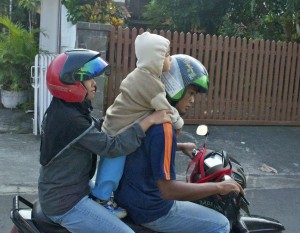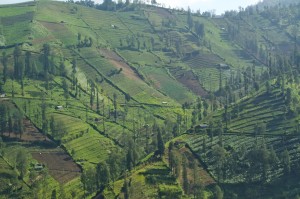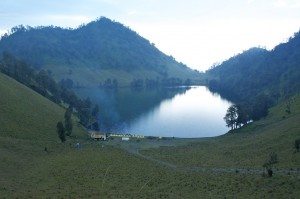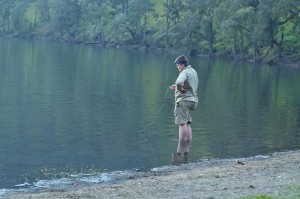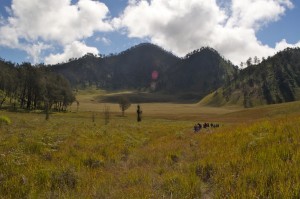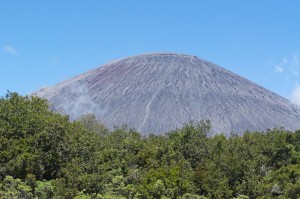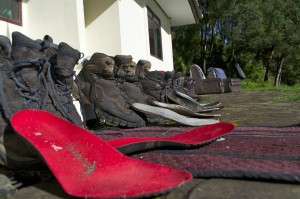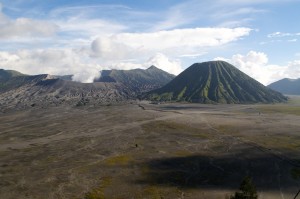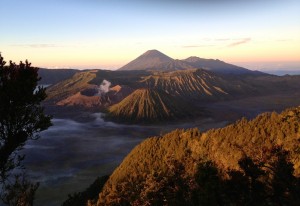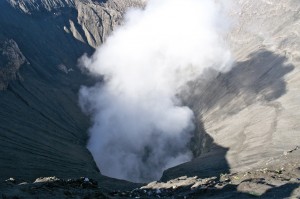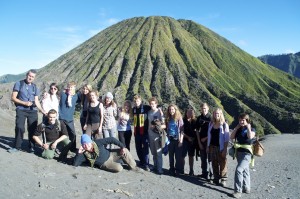Flying from Medan, we left Sumatra, and flew to Jakarta for a brief stop over before connecting with a flight to Surabaya, Indonesia’s second largest city. Following a meal in a restaurant not too far from the airport we drove by coach to Malang, a journey of about two hours. While most of the group slept in the coach, I had the disadvantage of sitting at the front and could observe what was happening in front of me. Not only did the driver seem to drive extremely quickly but some of his manoeuvres were frightening. I am used to differing standards of driving throughout the world and normally I am not affected by them, largely because most of the time everything is so much slower than in the UK. This driver was fast and the vast majority of the journey was through an urban sprawl with vehicles, motorcyclists and pedestrians often doing the unexpected. There was no room for error. Strangely, the vast majority of the time we were undertaking rather than overtaking, because lorries tend to occupy the outside lane. However, it seemed that it did not matter which side you overtook vehicles by but our driver relied very heavily on other drivers not changing their minds. I was happy to arrive at our overnight hotel in Malang in one piece.
Despite the lateness of the hour we had to sort our kit for the next day, ensuring that we only took what was necessary for the trek and left all unnecessary kit in our kitbags to be held in store once we reached the starting point of the trek at Ranu Pane. It was just as well that we did sort out our kit as Freddy came to my room to confess that he had been rather foolish and left his boots in Tangkahan, almost a thousand miles away in Sumatra. Emma confessed to not having sleeping bag. There is always a solution to any problem and it did not take long for Freddy to occupy my boots, filling the extra space with a second pair of socks, while I used my ageing trainers and Emma, like the rest of us would be supplied with a sleeping bag more suited to the mountain environment that our thin jungle bags.
As Malang was waking up the next morning we set off in a convoy of land cruisers for the final leg of our journey to the mountains. Nearly everybody has a motor bike and the roads were already becoming crowded as they jostled for position. The risks some people take with those closest to them is remarkable and there does not seem to be an authority to ensure that unnecessary risks are not taken.
Leaving Malang we began to climb. Emerging out of the haze in the distance ahead of us were conical shaped mountains and one, in particular, which seemed much higher than all the rest, Mt. Semeru. As we drew nearer and gained height the mountains began to show themselves more clearly. Semeru gave off a puff of smoke as it gave a volcanic cough, something it does about every half hour. It looked impressive with steep slopes leading up to the crater rim. What was closer was equally impressive.
We were entering a huge caldera with the ancient crater rim rising steeply for several hundred feet. The natural vegetation was lush suggesting that the volcanic remains are very fertile. That clearly became so when we saw the type of intensive market gardening that takes place on the slopes higher up. Not content with just one crop per field, the soil has the capacity to cope with three! Potatoes occupy the mounds striping the fields but between each mound cabbages are growing and all around the edge onions. The slopes are so steep that no machinery can work on the land, it all has to be done by hand. Drainage and soil creep must be an issue but there was no evidence of a problem as people worked on the precipitous fields.
Ranu Pane is a large village centred around a small lake (Pane – water) and which relies on agriculture and tourism for its prosperity. During the high season as many as 500 tourists a day can trek to Semeru, Java’s highest mountain at 3676m. In amongst all the farm houses are homestays and guest houses catering for this mass influx of people. At other times of year the houses lay empty.
On arrival we met our new crew and made final preparations for our trek to our camp at Ranu Kumbolo on the shore of a small crater lake. As we left the clouds rolled in giving an atmospheric feel to the place. The trees dripped on to us and lichen hung down from the branches; we were in a typical cloud forest. The path was easy and had been paved for the first few kilometres but even when the paving ran out the path was easy, only gradually gaining height. Every so often there were shelters for trekkers and crew to rest in on their 13km walk to Ranu Kumbolo. I was really disappointed to see lots of rubbish strewn about these areas, sweet papers, food wrappings and plastic water bottles. We had seen nothing of this nature in the jungle. Why was this area any different?
The clouds still rolled in and we were almost on top of the lake when it appeared through the mist. It is not a huge stretch of water but it took us a while to walk round to the other side where camp was situated on the shore. A line of tents a few metres back from the water’s edge was our camp for the night. As te sun came out it looked an idyllic spot. A couple of huts nearby denoted the kitchen area and accommodation for the crew. As we approached the camping area the litter increased and by the time we reached the tents there was an unacceptable level of waste. What a disappointment. Worse was to come when we discovered that there were no toilet facilities and that in the grass, among the trees and along the lake shore to either side of camp was a disgusting mix of human excrement and toilet tissue!
Lunch was eventually produced and while it was very tasty there was not enough of it, lots of rice but very little chicken or vegetable and we had to ration everybody to make sure that it was shared out equally. This was the norm for every meal on trek.
In the afternoon a group went off in search of fire wood so we could have a camp fire and cook the fish that Tom was going to catch with his makeshift line and hook. I took myself off for a little explore and to see if I could have a look at Semeru. Unfortunately the cloud kept it veiled from my gaze. By the time I returned the fire was burning and Tom was still creating his fishing line. Some of the porters were fishing with similarly makeshift lines, but, unlike Tom, they kept catching fish.
The following morning I woke early to watch the sun rise from the other side of the lake. The water was as still as could be, mirror like, but we did not get the early morning colours I was hoping for.
Today’s walk was only a matter of a three hour trek to Kalimati, the base camp for Semeru, so there was no rush. Before heading in that direction we went to explore the savannah of a nearby valley. It was spectacularly beautiful with a richness of colour to the grasses. It felt as though we should have been watching wildebeest and giraffe ambling across the scene.
After this short detour we headed off towards Kalimati, leaving our crater lake valley to cross a pass into another grassy crater area. There was still no view of Semeru. On the other side of the crater we began to climb up through some thin woodland to the opposite edge of the old crater. Many trees were severely charred from a fire which ripped through the area three years previously. While the larger trees were surviving all the smaller ones had perished. Nature was beginning to repair the damage but nothing would hide the charring effect.
Reaching the crater rim we got our first clear view of Semeru, a text book example of a cone shaped volcano. Semeru gives off a puff of smoke approximately every thirty minutes but it is still regarded as a very active volcano. At Ranu Kumbolo there are several memorials to people who have become victims of Semeru. In 1981 250 people we killed in an eruption and the last major event was in 2002 when two Pyroclastic flows travelled 2.5km down the mountain. Looking at the mountain you couldn’t help but think that getting to the top was going to take a few hours of hard work.
The path dropped down slightly to Kalimati and camp. If I thought Ranu Kumbolo was a litter strewn mess, Kalimati was ten times worse. There was rubbish everywhere and although some had been gathered into piles, nothing had been done to dispose of it. It was left to rot and attract flies, making the environment unpleasant. The afternoon was spent, away from camp, relaxing in the sunshine and conserving our energy for the early start for the summit. We met and chatted to some Malaysians who had been to the summit earlier in the day and they talked to us of seeing the sun rise in the east while also watching the full moon set in the west. They spoke eloquentyly about stunning 360 degree views etc. etc. We hoped for the same.
We were due to be woken at midnight, have a drink and a bite to eat before heading off for the summit at 1.00am. Sadly we were not very impressed with our leader and his crew. Communication had been minimal and there was no desire on their part to become involved with us. We hardly ever saw our leader and he had chosen not to come to the mess tent for the pre summit briefing the evening before. Needless to say the wake up call never happened and eventually a voice asked if we were ready at 12.50am. Needless to say it all became a bit of a rush and we finally left at 1.30am. This put me in a bad mood and I was not happy. I was also not happy with the conditions. High clouds were scudding across the sky at 50mph and a bank of much lower cloud, a front, was heading in our direction. I felt uneasy about the conditions and felt thewre should be some discussion with our leader who should also be able to read the conditions. Unfortunately, he did not want to enter into any discussion. Jim and I discovered that if we asked him the same question twice we got completely different answers each time. I began to question his suitability for the job and to wonder just how well he knew this mountain.
The first half of the climb took us through the forest, climbing steeply. The going was quite tough and I was now in the wrong frame of mind for this. I felt sure that some of the group would be suffering, both physically and mentally, but I am full of admiration for them as they stuck to the task very well. In the upper part of the forest it began to rain as the cloud thickened and then cleared again temporarily. We set out from camp with six guides to help with the ascent but by the time we reached the edge of the forest three, including our leader, had disappeared. It was a hard slog up the loose scree and the effort required to prevent feet from slipping back made it all the more tiring. Soon the heavy bank of thick cloud shrouded the mountain and visibility became very poor. It started to rain heavily and some began to struggle in the worsening conditions. Still the spirit was there and nobody showed any inclination to turn back, not until they were told that it was another two hours to the summit. Hearts sank and it was at that point that the decision was made to abandon the summit bid and return to camp. The descent down the scree slope proved interesting as the rain came down heavier and heavier. Thunder rumbled around the summit and by the time the forest was reached the path was a river of mud and water, making the steep descent slippery and treacherous. Remarkably, our chief guide re-appeared in the forest but was completely detached from the group and gave no help at all. By the time everybody reached camp they were completely soaked and bedraggled. It was cold and miserable. To make matters worse half the camp was flooded and before we could get into the tents we had to move them. Again, the crew were no help at all and our leader disappeared into his own tent rather than helping or instructing others to help. Now, not only was everything we were wearing soaked but also the rest of our kit. If we were to feel any comfort at all we needed to get off the mountain and down to Ranu Pane in one day rather than two. To make matters worse the guides who told us it was another two hours to the summit confessed that we were, in fact, only twenty minutes from the summit, well within reach and the capability of the group. The only positive we could take from that is that the conditions would have been far worse when higher up on the mountain. The prospect of camping on the lake shore at Ranu Kumbolo held no joy, particularly as our water for cooking and drinks was taken from the lake and the heavy rain would have washed a lot of the human waste into the lake.
The rain continued to pour very heavily and what was once a path was now a fast flowing stream. Having taken tea to everybody in their tents, I sheltered in one of the huts and watched, with horror, as some of the crew threw rubbish into the fast flowing water for it to be carried off. They were even taking bags of rubbish off the rubbish pile and sending them down. Inevitably these would get stuck somewhere and the litter problem, instead of being solved, would just become more widespread. The national park has a lot to do to both redress the problem and educate the local guides and crews to respect the environment in which they work. I would not want to return and could not recommend anybody else coming to this area until something concrete is done to both clean up and protect the environment. It is a stunningly beautiful area and deserves to be cared for.
We waited for the rain to ease but it kept coming in pulses so we made the decision that the longer we stayed at Kalimati the colder and more miserable we would become. Moving would keep us warm, so Jim took the first group who were ready and set off for Ranu Kumbolo. I followed with a second group a few minutes later. The paths were flooded but it did not really matter as our feet were already soaked. As soon as we climbed up from Kalimati and dropped into another part of the caldera the rain eased, suggesting that the worst of it was around Semeru itself. The path was very slippery in places and every-so-often one or other of us would slip and fall. This was where there was a marked difference between this crew and the one we had had for the jungle trek. On our walk out from Semeru, whenever anybody slipped and fell the crew would watch and then walk by. There was never a helping hand or support or guidance of any kind. Such a contrast.
Following lunch at Ranu Kumbolo we headed back to Ranu Pane, but not by the route we had come in by. Our guide told us that there had been a landslide and that it was dangerous. The alternative route took us into the savannah grasslands and a long, treacherous climb over the rim of the caldera. The path was so slippery we would have been better off with crampons, and there were signs of landslips on the more exposed parts of the path. Meeting other trekkers who had used our original route, I leasrned that there had not been a landslide and that the path was safe.
The group became fragmented and I found myself, along with a guide, walking with four tiring girls. It had been a long day. They had been up and walking for the best part of fourteen hours in less than comfortable circumstances. While resting, our guide just disappeared and we never saw him again. As a result, we took a wrong turning and walked for an unnecessary extra hour as we approached Ranu Pani.
By the time we reached the lodge where we started I was furious. Most of our crew had disappeared home and nobody knew where the key was to release our kitbags from a store room. Our discomfort had to be endured further. In the meantime we looked at some lakeside rooms and decided we would stay there for the night. The accommodation was in quite pleasant, lakeside houses, and we chose one for the girls and an adjacent one for the boys. As soon as we were able to release our kitbags we were able to feel a lot more comfortable.
The following morning the sun was shining. We struck very unlucky with our Semeru ascent day, but in some respects, experiencing the conditions we did, actually made the day more memorable. Jim and I were up early and began to sort out our wet kit, hanging it in the sunshine to dry. We also collected everybody’s boots a lined them up on the terrace overlooking the lake. Steam soon started to rise from them and the clothes above.
Gradually the students began to emerge and sort their kit. We were not leaving until after lunch so there was a fair chance that most of it would dry, providing the weather remained favourable. The students appreciated the opportunity to relax.
I can’t say I wasn’t disappointed to leave Ranu Pane. We left behind most of the crew but still had our leader and a couple of his most senior assistants. During the short journey to Bromo I tried to strike up a conversation with them but they seemed reluctant to get involved. Driving up a savannah type valley we rounded a corner and entered a barren desert like area of volcanic dust, the result of Bromo’s last major eruption in 2010. Passing spectacular volcanic scenery we climbed out of the valley to our hotel on the edge of Bromo village. This was luxury after our experiences of camping on Semeru and we were having some time to enjoy it. The view from the hotel was stunning and I felt sure that this was going to be the highlight of our time on Java.
The following morning we got up at 3.00am for a 3.30am start, travelling in land cruisers, to a view point for the sunrise. As we left our rooms there was a strong smell of sulphur in the air. There were headlights all over the valley and the hillside opposite as just about every tourist in the region seemed to be going to the view point. The congestion of vehicles near the top meant we had to walk the last few hundred metres, passing a host of small trinket stalls and cafes. The viewing platform was crowded and there was a buzz of anticipation as the sky in the east began to lighten. It reminded me of the occasion when I was staying in Darjeeling and went up Tiger Hill to watch the sunrise over Kangchenjunga. It was a similar atmosphere.
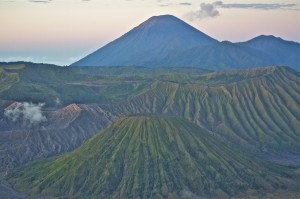
The view at sunrise with Bromo smoking in the foreground and Semeru sending out a puff of smoke in the background.
Gradually the sun rose casting a beautiful light on the volcanoes in front of us. Bromo was smoking constantly but there were occasional puffs of smoke from the towering summit of Semeru in the distance. It was stunning, such a moonscape. Once the sun was up everybody began to leave. Knowing it would be chaos as the hundreds of land cruisers sorted themselves out, we went into a small cafe for tea, coffee and banana fritters.
While there I decided to pop back up towards the viewing platform to use the toilet. While there I took the opportunity to go up to the platform for one last look. It was deserted, yet the light was better than it had been earlier and it was a great photo opportunity. The occasion was enhanced by the fact that I was alone and only I could see this view.
Eventually we returned to our vehicles and descended the hill to the valley below. The valley was still shrouded in early morning mist giving it an even more pre-historic look. The vehicles were now taking us across the valley to the foot of Bromo. It appeared that most people had done the same. There were many horses by the vehicle park all wanting to take people to the foot of the staircase leading up to the crater edge. Staircase? Yes, they have built a staircase to make life easier, particularly, I guess, for the many Hindus who come here offering gifts to the gods. Standing on the rim of the volcano we looked into the smoking crater. The whole of the rim, the steep slope up to the rim and the even steeper slope down into the crater was covered in the remains of offerings, food wrapped in banana leaves, flowers etc. Men were inside the crater, precariously moving to pick up the litter and coins thrown in as offerings. The offerings, while numerous and distracting, I could understand but what I found unacceptable were the plastic bags that they were carried in. How can you hold a place in such high regard but not treat it with the respect it deserves?
As fascinating as Bromo was, I was disappointed that we could not see molten lava bubbling away. I was possibly more impressed with the adjacent peak, a perfect cone scoured by channels and ridges all the way round. It was perfect and the vegetation that was colonising it was vivid. I learned that while we were there there was a BBC film crew filming in the crater.
It had been a fabulous morning. We returned to the hotel for breakfast before minibuses arrived to transport us back to the airport at Surabaya for a flight to Bali and the beginning of phase three of our Indonesian adventure.

